Search for lenses, articles and help
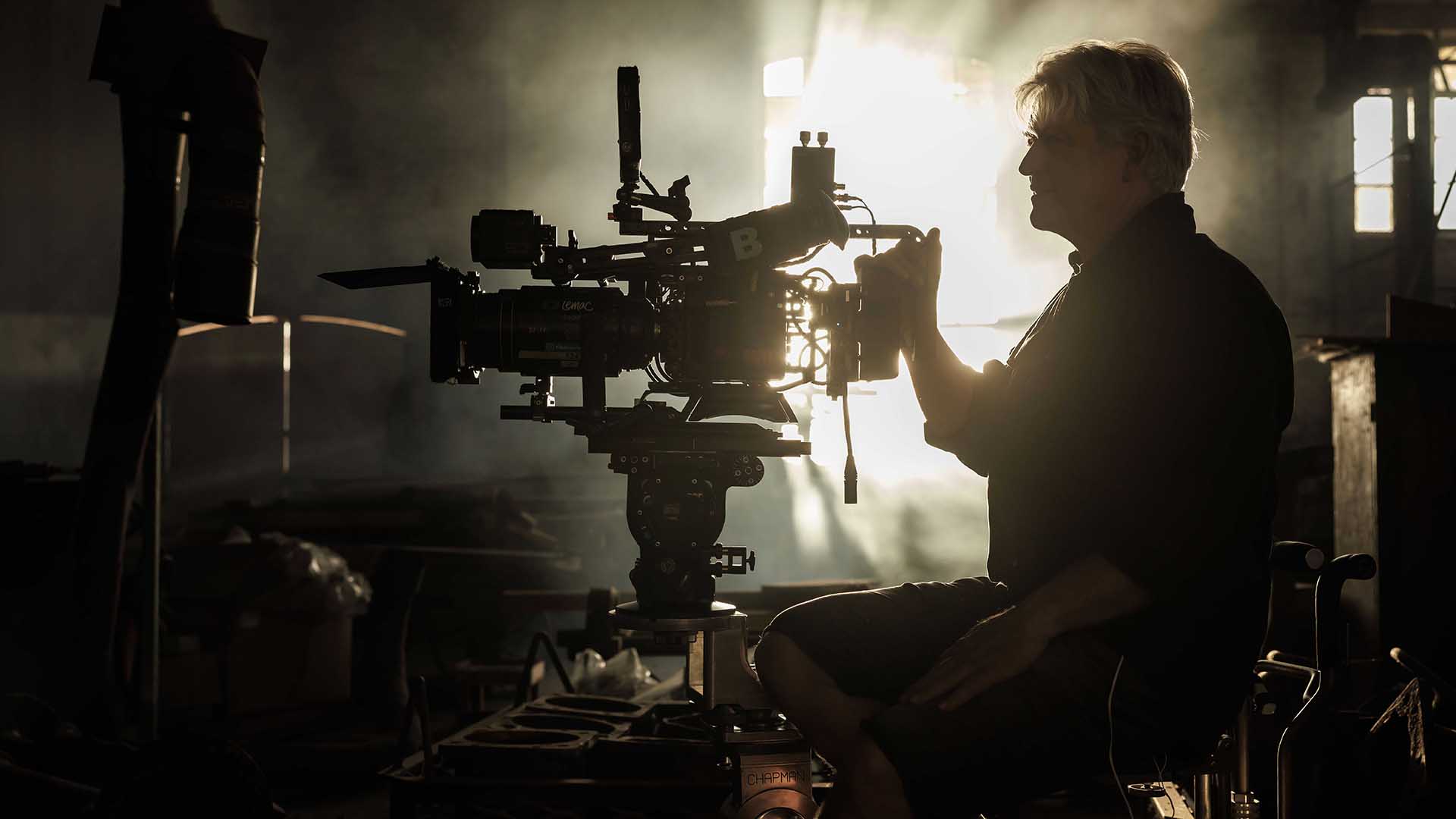
For our inaugural ‘Through the Lens’ article, Cooke profiles internationally acclaimed Australian cinematographer Ben Nott ACS.
Throughout his distinguished career, Nott has built an impressive filmography spanning feature films, television series, and commercials. His achievements include a Prime-Time Emmy Award nomination for his work on the Ridley Scott-produced miniseries ‘The Company’ which won him a prestigious American Society of Cinematographers award.
In 2016, he received the AACTA award for cinematography for his striking work on the science fiction thriller ‘Predestination’. In 2019, he was awarded Best Cinematography at the Film Critics Circle of Australia awards for ‘Danger Close: The Battle of Long Tan’, a demanding war film set during the Vietnam War. He’s garnered three Milli Awards, the highest honour awarded to Australian cinematographers.
Most recently released is Nott’s spellbinding work on ‘Nautilus’ (2024), a ten-part adventure drama reimagining of Jules Verne’s 1870 novel “Twenty Thousand Leagues Under the Seas.” For this project, Nott utilised Cooke’s Anamorphic/i FF Lenses in both Special Flair and regular configurations, bringing a distinctive visual language to this deep-sea epic. He recently completed principal photography on the upcoming second season of ‘Monarch: Legacy of Monsters’.
Come with us as we explore his compelling journey into the world of film, pragmatic approach to visual storytelling and how his adaptable and agreeable nature has helped shape a varied and prosperous career.

Ben Nott ACS
To understand Ben Nott’s intuitive approach to cinematography we go back to his origins. Growing up in the Bush on a cattle station in far Western Queensland, Nott developed a no-nonsense relationship with the world around him from a very early age. This upbringing, characterised by hands-on problem-solving and an intimate relationship with the natural environment, would later inform his approach behind the camera.
“The thing about growing up in the Bush is that you develop as a really pragmatic person by default because you become incredibly practical,” Nott reflects. “You’re given large responsibility and start driving all manner of trucks and tractors and things at a stupidly young age. I guess you develop kind of an innate sense about how to navigate the natural world in some ways.”
This foundation of practical problem-solving would become the bedrock of Nott’s cinematographic approach. “Essentially as cinematographers, you can wax on that we’re incredible artists and we’re this and that – but ultimately we’re paid problem solvers, and we solve hundreds of problems a day.”
The responsibility placed on young shoulders in the Australian outback fostered in Nott an ability to think on his feet and adapt to challenging circumstances—qualities that would serve him well in the high-pressure environment of film sets years later. “We’re just a time-driven artistic army,” he notes of film production teams. “So you must understand the time clock. You must pay homage to the time clock.”
Growing up in the Bush meant only one TV channel, ABC the national broadcaster. Whilst Nott didn’t grow up immersed in cinema his father was quite into films and introduced him to the transformative power of the movie-going experience.
“One day he said ‘right, everyone get dressed – we’re going into town’. And he put us all in the car at about three o’clock in the afternoon. We didn’t quite know why we’re going to town; I was like six or something like that… and he goes, ‘I’m taking you to the movies’. And so, we went an hour and a half into town and saw ‘Live and Let Die’ at the drive-in.”
The experience left an indelible impression on young Nott. “This huge, corrugated iron ‘screen’, basically the side of a shed and these tiny little tinny speakers that you hang on the inside of your car. The vision was great but the sound was uber shit. I remember we turned the station wagon around and we’re all in the back with the blanket watching this film and it was absolutely amazing because we’re close to the front, it was massive and just filled our periphery.” The allure of the film industry was taking root even if Ben didn’t quite know it yet.
Nott’s path to cinematography was anything but direct. With a mother who shouldered the immense responsibility of running a cattle station and raising four boys after the early loss of her husband, there was pressure to pursue a conventional career path which was enforced by a boarding school education – traditional in this part of the country where swaths of land are so sparsely populated.
“Her kind of unspoken caveat was that we had to be a ‘someone’ at the end of this,” Nott explains. “Her idea of a someone was a doctor, a dentist, a lawyer or whatever. And so the arts and humanities were very much pushed to the side and to be totally fair to my mum I did not display any aptitude for the arts so her expectations were not unreasonable!” Nott initially pursued a science degree at the University of Queensland focusing on physics and geology. “Physics is such an amazing subject because it’s so practical and in the hands of a great teacher who positions it in the real world, it’s a very easy science to relate to. I studied lenses and I studied light from a textbook without knowing these were to be become essential tools to be used later in life!”
Blessed with a reasonable short-term memory, Nott excelled academically without necessarily engaging deeply with the material. “I could read the textbooks, and I could spew them back out in a test and pass really well. And that’s essentially what I did all through university… I didn’t really work at it. I wasn’t really super interested in it. But I got really good marks.” The breaking point came during his fifth semester, just one year shy of completing his degree. “I came into a physics lecture and I hadn’t held a pen for three months. And this lecture’s just writing out these equations on this board… and I’m copying this stuff down flat out. And part of my elbow is getting so sore because I was writing, and I wasn’t used to writing.”
Looking around the lecture hall, Nott noticed his fellow students weren’t taking notes. When he asked a classmate why, she informed him the professor was merely recapping material from the previous semester—material Nott had already mastered and forgotten. “I’d aced the test. I was learning nothing because I was just cramming and regurgitating without absorbing. And so that was it, Eureka moment #1. I closed the book, walked out and quit university. I was twenty-one.”
What followed was a two-year period that Nott describes simply as “I went surfing”, much to the chagrin of his mother. Whilst working a bar in the surfing town of Noosa Heads, Queensland clarity struck again.
“I was pushing beers across the bar to these guys who come in every single day. They’d sit in the same stools, and they’d drink the same drinks and they’d have the same blood shoot eyes and capillary busted noses. They were just barflies,” Nott recalls. “And I remember looking at this guy’s eyes one afternoon and thinking, ‘I’m just becoming one of you. I’m becoming you.’ And there it was… Eureka moment #2. Books closed. I’m out of here – metaphorically – I’ve got to go find something that’s worth investing in…. and I’ve got to be someone. I don’t know what that someone is.”
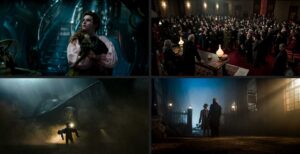
Ben Nott ACS’s work on 2024 Amazon Prime series ‘Nautilus’
Nott moved to Brisbane where he answered a newspaper advertisement for a share house. “I moved in with this nice guy and I’m snooping around the house on the first day when he’s gone off to work. It’s a three-bedroom house and one of them is locked tight with a padlock and the windows were blacked out with pungent chemical smell wafting out from beneath the door. Now I’m thinking crackhead, I’m thinking meth lab and I’m seeing the drug squad busting down the front door.”
Nott confronted his new housemate. The revelation that followed would change the course of Nott’s life: “He laughed, and he went and unlocked it, and I look inside at all this stuff – an easel, bits of string, pegs with paper hanging, trays, and a cool red light. ‘It’s a dark room. This is where we develop film and images. Have you ever taken a picture?’ And at the ripe old age of 23 I confessed I had not. He handed his SLR equipped with a 50mm lens and said, “We are about to change all that.”
“With the camera set on automatic exposure, a basic instruction on manual focus, a pep talk to ‘just shoot and not think’ my new friend launched my first photographic adventure.”
The real magic, however, happened later in the darkroom: “Together we developed the film and then we put the first piece of negative on the easel and shot it onto the paper. The instant I dropped the paper into the developing tray initiated an unforgettable moment of pure magic. An image appeared. Eureka Moment #3 – this magic was going to play a part in my life forever.”
For Nott, this transformative experience represented a perfect fusion of science and art—an integration of the technical interest he’d acquired during his university studies with a new form of creative expression. This thing called photography was a cool mixture of all the sciences. There was physics happening all over the acquisition phase (light and lenses), chemistry going on in the darkroom, and a practical aspect to the general approach. Via my left-brain science background, I could relate to the basic concept but not yet in a right brain creative way. The magic of that first experience was the driver to bring both hemispheres together.”
What followed was an intense period of self-education and obsessive practice that would make Malcom Gladwell proud. “The hook was set and I just went nuts. In the next three years, I shot thousands and thousands of images and by rote, reversed engineered the whole process.” Rather than pursuing formal education in photography, Nott learned through experimentation and failure, developing his technical and artistic sensibilities through relentless practice. “Not by reading books, not by going to courses, not by attending film school, just by suffering vitamin D deficiency by living in the dark room!”
This approach allowed Nott to develop a comprehensive understanding of the photographic process: “I had a chance to redeem poor composition on the easel, poor exposure by compensation. I learnt about the basics of the toe and shoulder of the exposure curve by dodging and burning the image. These learnings I took back out to the acquisition phase and slowly narrowed the correction gap required back in the darkroom”. This formative period established a foundation that would guide Nott’s entire career: “Whenever there’s a creative conjugate the science helps to bail me out. It never saves you creatively, but it puts you in a position where you feel comfortable to be able to make a creative decision based on a good practical foundation.”
Unlike many cinematographers who develop their visual sensibilities through exposure to art galleries, cinema, or formal education, Nott’s aesthetic evolved organically through his darkroom experiments. “I could line up the contents of the wastepaper bin and see a definite progression to reach a goal, because even if something was slightly off, I would bin it and try again until I got it right. I’d be in there for like six hours to get one perfect exposure. It goes without saying I had to do a lot of shelves stacking at the local supermarket to support my newfound habit.”
Crucially, Nott was defining his own parameters of quality and beauty. “It was my perfect, it had nothing to do with anyone else. It was very much an insular process surrounded by four dark walls and a red light and that’s what’s formed me creatively into who I am.” This self-directed aesthetic development has fostered in Nott a strong emphasis on originality in his work as a cinematographer.
Nott’s housemate worked as a focus puller and through his connections Ben began working on film sets, starting at the lowest rungs of the production ladder. “That’s the building blocks of how I arrived; as an extension of going out on the set with this guy, I really started at the very, very bottom. I was a runner, an assistant grip, assistant electric, an assistant to anyone that needed assisting! I did a whole bunch of everything and then stumbled into the camera department when there was an opening.”
This comprehensive ground-up education gave Nott invaluable insights into every aspect of production. “That has led me to a point where now I’m very comfortable in the decision making process. I understand the problems that I am setting people. I understand the magnitude of the task and I have an understanding of what it takes to execute that task in terms of time, manpower and cost. The general practical notion of being able to manage a set and manage time was really born out of starting at the very base of the film making tree and then climbing up the branches.”
Beyond the technical education, Nott was immediately drawn to the unique social dynamics of film production. “I gravitated to the camaraderie. My beginnings were in the 80s, which was kind of like the heyday of advertising and filmmaking. It seemed like there was so much money around. Productions were lavish and expensive, and egos were big. It was quite amazing. It was like wonderment—it was really fantastic.” Nott observes that the industry has changed significantly since then. “With successive GFCs and all that, things have constricted – we now need to be clever with every single cent. Which is okay too, but it was certainly a different deal back then.”
As Nott began to further integrate into the film community through his housemate he encountered film students and industry professionals discussing technical aspects of cinematography. “I’d listen to them around the table talking about technique and lenses and filters. And I didn’t really understand what they were saying, and I had for a long time this incredible anxiety about the stuff I didn’t know.”
This anxiety eventually gave way to a realization that would become central to Nott’s approach as a cinematographer: technical knowledge, while valuable, can sometimes inhibit creative exploration.
The insight that ignorance of technical limitations could foster creativity has informed Nott’s approach throughout his career. “I figured out that actually not being super, super technical, leaves space in my head for all of this other stuff to flow in. I don’t automatically discard concepts that the theory says maybe I should.” As he puts it succinctly: “The manual hasn’t told you don’t do this, because you haven’t read the manual, you go ahead and do it. There are plenty of failures of course but the odd, rare gem is unearthed.”
This approach has evolved into a deliberate methodology. “I surround myself with people who are very technical. I don’t really want to fill my hard drive with some technical info, but I want to know that someone in the circle is up to speed – so I can access it from them when I need it. I like to instead keep that part of my brain open for whatever floats in from left field… it may sound a touch arrogant and stupid, but essentially that’s how I function.” The result is a cinematographic style guided more by intuition than rigid technical rules.
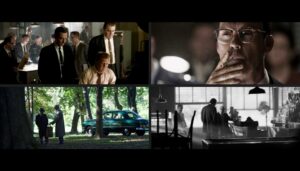
Ben Nott ACS’s work on the 2007 limited series ‘The Company’
Nott’s career trajectory took a significant turn with his work on ‘The Company,’ a Ridley Scott-produced miniseries released in 2007 that earned him a Prime-Time Emmy Award nomination. His involvement with the project came through director and cinematographer Mikael Salomon, with whom he had previously worked on ‘Nightmares & Dreamscapes: From the Stories of Stephen King.’
Nott recalls. “Robert Littell’s original story about the CIA made for 6 hours of awesome television”. ‘The Company’ also marked Nott’s entry into digital cinematography during the format’s early days. “The production of that show roughly coincided with the release of Arri’s first digital camera system. The D20 had been employed on one other job, and I believe we were the second production to use it. Understandably the D20 was a long way from the awesome Arri products now available, it was a big, clunky, angular tethered thing with very limited options in terms of light sensitivity.”
As one of the early adopters of a new technology, Nott became part of the camera’s development process. “ARRI serviced the job out of Munich and as a byproduct of taking the camera gave us the best of everything else – a great deal on all the lighting and all the lenses. And we this one tech in particular who’d travel with us – his job was to take notes in the field and send them back to ARRI who would update the cameras. Basically, we were doing R&D on the run.”
The limitations of early digital technology forced Nott to adapt his lighting approach, ultimately expanding his technical repertoire. “Film negative at the time was vastly superior in its ability render a pleasing roll off on all aspects of the exposure curve: the shoulder, the knee and the toe. Meaning a single soft source placed at 45 degrees to the subject would wrap beautifully around the curves of the body /face and fall off gradually to black on the fill side. The D20 rendered this curve (fall off) in a very different way. Shadows plunged to black super quickly. The D20 had a very sharp kink in the bottom of the exposure curve so I had to effectively light the missing part of that curve back in, employing more lights rather than a single key and fill. Having to deal with the rudimentary nature of the sensor’s capability, I learnt loads about the subtleties of lighting, exposure and contrast to try and emulate the film medium to which I was accustomed.”
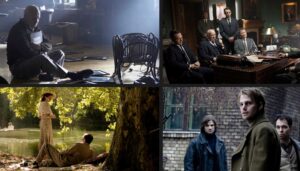
Ben Nott ACS’s work on the 2007 limited series ‘The Company’
Following his experience with the Arri D-20 on ‘The Company,’ Nott continued his exploration of early digital cinema systems with the Panavision Genesis on ‘Daybreakers’ directed by Michael and Peter Spierig. The transition required Nott to develop new methods for maintaining exposure control. “I remember going into Panavision and talking to their head tech about it and asking about why my light meter wasn’t corresponding to lens iris markings and hence the exposure of the image that I’m seeing on the monitor. That was a bit of quicksand for me there for a minute thinking ‘I’m not quite sure about this thing because now I’m just going to have to throw this meter away that I’ve used forever and just look at the TV.'” The solution came through rigorous calibration of monitoring systems. “I’ve become very pedantic about the setup and calibration of a monitor because it’s the light meter of today.”
Despite his initial resistance, Nott eventually embraced digital cinematography. “I have to say that nowadays I’m completely in the digital world. The immediacy of the image is far too alluring, it’s just amazing. When you think about it from a risk management point of view, this whole notion of setting something up and spending all this money and energy and shooting it on film and then not knowing until tomorrow how it turned out when you’re in a completely different location, doing a completely different thing, is a weird economic metric.”
This doesn’t mean Nott has abandoned film entirely. He finds value in using analogue equipment for specific aesthetic effects that digital can’t replicate. ” The hand crank film camera is a weapon. I miss the roll up and roll off flashes from a film camera set to 100+ frames per second and the change of exposure that comes with it. These affects can be somewhat mimicked editorially, but are unable to be achieved fully in the digital realm.”
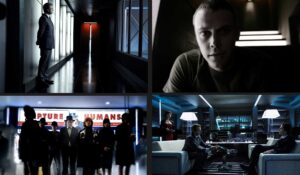
Ben Nott ACS’s work on the 2009 feature film ‘Daybreakers’
Nott’s early work with digital cinema systems places him among the vanguard of cinematographers navigating the transformative shift from film to digital. This transition began in earnest around 2000 when director George Lucas and cinematographer David Tattersall BSC became the first filmmakers to shoot a major Hollywood production digitally, using a Sony HDV-F900 for ‘Star Wars Episode II: Attack of the Clones,’ released in 2002.
This pioneering effort sparked a rapid development of digital cinema cameras. The industry witnessed a surge of innovation whilst the cinematography community vigorously debated key limitations of early digital systems, particularly the reduced size of ⅔” imagers compared to 35mm film and whether 1920×1080 resolution was sufficient for theatrical presentation. Throughout the 2000s, manufacturers raced to develop digital cinema cameras that would provide higher resolution images and accommodate traditional cine lenses.
The Panavision Genesis, developed in partnership with Sony and released in 2004, represented a significant step forward. Though its output was limited to 1920×1080 HD, it featured a 5.7K monoplanar Super 35-sized imager. The camera was used on more than 70 feature films between 2006 and 2012, offering RGB444 colour and compatibility with cinema-quality spherical lenses—addressing key shortcomings of earlier digital systems.
Arri followed with the D-20 in 2005, utilizing a 35mm sensor adapted from their ArriScan. This rental-only camera could capture up to 2880×2160 RAW 12-bit footage and featured a mechanical shutter adjustable from 11.8º to 180º. The D-20 was replaced by the improved D-21 in 2008, which featured higher sensitivity and automatic defect pixel correction.
The digital cinema landscape was dramatically transformed in 2007 when Red Digital Cinema, founded by Oakley sunglasses magnate Jim Jannard, released the Red One 4K camera. Despite early technical issues, the Red One democratized professional digital production and challenged established manufacturers. Just two years after releasing the D-21, Arri set a new industry standard with the 2010 introduction of the Alexa camera, which has since been used to capture hundreds of feature films and is Nott’s current camera of choice in its more recent iterations.
The transition to digital cinematography altered the physical dynamics of the set, requiring Nott to develop new workflows to maintain creative intimacy with the process. “Composing the frame is one of the joys of doing the job. Nobody knows that better than a cinematographer. I think Camera Operating is the best job on the set, no question about it.”
Film cameras had fostered a particular set dynamic that Nott valued. “I found my eye became so attuned to the optical viewfinder of a film camera that exposure, contrast and hue judgment calls were made through the finder. The camera is the focal point of the set and so having the key players sitting on or around the dolly made for better communication.” Digital systems disrupted this arrangement. “Much of that intimacy disappeared, we humans are always lured to the sweetest fruit and the sweetest fruit in the digital film making world is the good old high-definition monitor, usually positioned away from the set and camera.”
The physical separation from the camera created inefficiencies that troubled Nott. “The decision-making had to travel an extra fifty feet and with that comes an obvious inefficiency. The crew look for answers and have to resort to leaving their post on the set, yelling out or waiting their turn on the radio to get those answers. I really didn’t like being removed from the filmmaking nucleus in that way.”
Now Nott operates the camera remotely via a geared head fitted with hot wheels cabled to remote wheels that sit beneath a monitor trolley. This arrangement has significant advantages for director collaboration. “I sit as close to set as possible in front of my monitor, my new viewfinder, right next to the director. I find that it empowers directors enormously to have a camera operator sitting beside them; if they want to change their mind or change something about the composition of the shot mid-stream, all they need to do is whisper and it will happen. They can craft the frame exactly how they want, so it’s probably the closest they get to actually operating and I’m sure that removes a lot of frustration.”
Despite these workflow changes, Nott maintains his appreciation for the final colour grading process. “I love the colour timing process. It’s so rewarding to craft and polish the edited footage without the same onset pressures that prevailed when it was shot, and also great to finally see the VFX work in context.”
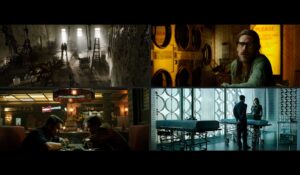
Ben Nott ACS’s work on the 2014 feature ‘Predestination’ directed by the Spierig Brothers
Nott has worked with The Spierig Brothers – German-Australian identical twins Michael and Peter on numerous films including ‘Daybreakers’ (2010), ‘Predestination’ (2014), ‘Jigsaw’ (2017), and ‘Winchester’ (2018).
When he first began working with the directing duo, Nott was uncertain how the dynamics would function. “I just got a feeling that I’m going be run off my feet because I’m going do this for this guy and then this for the other guy and then this for guy #1. But no, it didn’t work like that.” Instead, Nott discovered that the brothers’ dual perspective offered unique advantages. “Being a directing duo is really powerful given the elevated level of information two heads can process and the energy they maintain across the set on a daily basis and across the project as a whole.”
“They’re both great filmmakers in their own right. But when they’re together I will gravitate to Peter for more technical questions – matters of the head, and Michael for questions
relating to story, art and wardrobe etc – matters of the heart. This is of course not hard and fast, but a general navigational tool relating to my personal relationship with them.”
There is no division when interacting with their actors however and Nott observed that they always present a united front. “Their opinion is solidified at the monitor. And then they present that opinion, an idea or a note as a united front. They understand the importance to an actor or crew member that they feel there’s a unified voice steering them in a single direction.”
When disagreements arose between the brothers, Nott noticed a pattern in their resolution. “If there is a difference, it will resolve via the most passionate response. Both Michael and Peter will concede to the most passionate response. No brooding … no bullshit … onward!”
‘Predestination,’ a time-travel thriller starring Ethan Hawke, earned Nott the 2015 AACTA Award for Best Cinematography. The teams second collaboration it saw the Spierig brothers taking on a dual role as both directors and producers which altered the production dynamics. Previous to this ‘Daybreakers’ had been extensively storyboarded, the approach on ‘Predestination’ allowed for more spontaneity and discovery during production.
Despite budget constraints on ‘Predestination,’ Nott found that the financial limitations actually enhanced the creative process. “I don’t think that having to perform in a challenging environment is necessarily a bad thing. The old adage ‘If you want something done, ask a busy man’, certainly rings true in our profession… I find myself being addicted to the adrenaline triggered by situations where I am battling the clock. The true high is, shooting an impossible call sheet without sacrificing quality and other humans along the way. This can only be achieved by a well drilled and talented cast and crew, good prep and a great plan.”

Ben Nott ACS’s work on the 2014 feature ‘Predestination’ directed by the Spierig Brothers
Nott’s approach to leadership as a cinematographer is informed by his previous experience working in so many roles on a film set. This ground-up experience has shaped Nott’s leadership philosophy, which centres on respect for every team member regardless of their role. “I don’t think that my job title makes me any more important than anyone else. I believe in universal respect – it’s as important to respect the person who’s delivering the tea as it is to respect the guy who’s delivering the movie, on a human level they are the same to me.”
This egalitarian approach, Nott believes, contributes to a more cohesive and effective team. “I think once your crew understands that about you, you can start to get a cohesion, and it becomes a force because people want to work for the movie and they want to work for and with you.” Nott explicitly rejects the notion that pressure and tension create better results. “I can’t understand people who run the sets in an oppressive environment under a false impression that if people are more on edge they work hard and they don’t relax. I think that’s all bullshit. For me, I’d like to cultivate an environment that’s inclusive and we’re all together and the best idea wins.”
Nott sees his role not as the sole creative voice but as a curator of ideas. “I know that I’m the arbiter and I’ve got to filter those things, and it can’t just be 100 different ideas coming in but allowing people in creative space to have input, you’re empowering them and therefore you are upscaling the machine. You’re making the machine work faster, harder, better, stronger. And that plays out on a daily basis. You might not see it on a commercial, but on a six-month show, you’ll definitely see it because that energy stream can’t come from me all the time, it’s got to come from a collective that assumes ownership.”
One manifestation of Nott’s collaborative approach is his attitude toward on-set monitoring. “I am actually a huge advocate for dispersing monitors. I think that the makeup department should be watching their work, they should have input into their work.” This extends beyond mere access—Nott ensures consistent quality across all monitoring stations. “I make sure that as part of the monitor calibration process, I calibrate 20 monitors because I know that four or five of them are going to be sitting out there somewhere in the stage, and I want them to be the same as mine.”
When asked if he’s protective of the image, Nott’s response reflects his healthy confidence in his own abilities. “If I’m happy with the image, I’m pretty sure everyone else is going to be happy. So I’m good with that. I’m not trying to protect that in any way, shape or form. I don’t feel that I have to.” This openness has practical benefits as well, enabling input from unexpected sources. “On more than one occasion, on every film the grip’s whispered in my ear ‘what about that?’ And I go yeh – thank you very much. Or someone will say something about something in frame ‘does that annoy you?’ And yeah, I realise it does and adjust. Ultimately, you can only profit from empowering everybody in the end. And it’s not me that profits it’s the film that profits, that’s a normal part of the process as far as I’m concerned.”

Ben Nott ACS’s Cooke anamorphic work on ‘Danger Close: The Battle of Long Tan’
Nott’s exploration of anamorphic lenses has been driven more by creative discovery than technical interest. “I never really delved into the build from a scientific point of view, it was more just the joy of discovery, plugging in an anamorphic lens and going ‘oh fuck look at that!’” His work on ‘Danger Close: The Battle of Long Tan’ directed by Kriv Stenders employed Cooke Anamorphic/i S35 2x lenses in challenging jungle settings. “In that environment, you’ve got the sky eating through the leaves and becoming tiny little point sources of light and each one of those becomes a part of the bokeh. And in anamorphic that was just amazing, it was so incredibly awesome and the apparent depth of field being shallower along with the edge distortion was a fun thing to play with.”
The S35 series offered Nott distinctive characteristics across different focal lengths in a colour-matched series which didn’t go unappreciated. “I also like the fact that Cooke have designed into their lens sets at least one focal length that feels bespoke. These are interesting portrait lenses, whereas the remainder are a touch more straight, corrected optics. I think it’s great that there’s a variety, they’re not just ABCD. There’s a variety within the look and feel of them and I gravitated towards that.”
For ‘Nautilus,’ Nott chose Cooke’s Anamorphic/i FF 1.8x lenses after extensive testing. “The interesting thing about the 1.8x FF Cookes and the reason why I settled on them was that they have a great synergy between being distorted and being true. Because it was an ensemble cast, up to eight always in the frame and quite often spread across the frame I needed a lens that was edge to edge reasonably true. But also had the anamorphic quality and that distorted quality was more defined in some ways top and bottom than it was the left and right edges.”
The production leveraged different variants of the lenses for different scenes. “We had two sets of non-SF and a set of Special Flairs. We’d reach into the Special Flair box whenever we had something cool and then play the non-specials for straighter drama stuff. I like the fact that they offered a more deconstructed set that was in the same family.”

Ben Nott ACS’s recent Cooke anamorphic work on 2024 Amazon Prime series ‘Nautilus’
As visual effects have become increasingly integral to filmmaking, Nott has developed specific approaches to collaboration with VFX departments based around mutual respect. “I think it’s important to establish a great relationship with the supervisor – number one. They have to understand the DP’s sensibilities and sensitivities as we have to understand theirs and we have to understand what their limitations are.”
This understanding extends to the practical realities of budget constraints. “We have to understand the commerce and art thing, we know there’s only a certain amount of money in the pot – you can be really clever about how you spend that money, or you can be cavalier about it. It’s important to have that relationship with the supervisor in that they know and understand that you will do your best to try and remove the small tickets (small paint out issues) to support delivering the big tickets.”
Beyond the practical considerations, Nott emphasizes the importance of a shared creative vision. One key tool in this alignment is concept art. ” I’ll have the art department or digital artist do keyframes of important, cornerstone moments, so that we all understand the general tone – we understand how dark, how bright, the hue, the general visual intention is conveyed via this artwork. So together we’re producing something that’s in simpatico rather than this kind of back-and-forth situation that can result in many renders to get to a place that could be arrived at in few.”
Nott’s recent work on series 2 of ‘Monarch: Legacy of Monsters’ highlighted the particular challenges of scale in VFX-driven productions. “I had no concept of how big certain creatures were. Sometimes three hundred plus feet tall. The only way to compose shots and plan a sequence that involves actors and these huge mythical creatures is via extensive previsualization. Lens height, focal length and required depth of field can all be calculated by accurate previs.
Nott believes that cinematographers must embrace involvement with VFX rather than maintaining distance. “I just do not see how you cannot be involved. You have to be involved because every action has an equal and opposite reaction. What they do depends on what we do, what we do depends on what they do. And when you’ve got that line of communication that’s open and in simpatico you create magic.” He also advocates for ensuring VFX departments have the time and resources they need during production. “It’s especially important that we give the visual effects department their dues on the shooting day and the time they need because that will affect the quality of end result and potentially save hundreds of thousands of dollars later.”
Nott observes that audiences have an innate sensitivity to visual effects that don’t quite work. “The instant something is off, you just go ‘Oh, this is not real’.” This sensitivity has taken on new dimensions with the rise of AI-generated imagery. Despite the initial allure of new technologies, Nott believes humans ultimately respond to imperfection and authenticity. “I think as human beings initially we’ll be enamoured by something that sparkles. But I think we gravitate back towards the slightest imperfections.” This human element, Nott believes, will retain its value even as technology advances. “I believe that going forward we as humans, that’s what we’ll crave. We’ve all seen these incredible generated images and artworks and it looks like someone’s been on Photoshop on steroids; but I tap out on them because they just don’t have a heart and it’s throwaway.”
The value of Visual Effects, in Nott’s view, lies in their ability to create convincing reality rather than mere spectacle. “That reality factor that they bring in and the organic factor they bring into the texturing is so important to make it feel like it’s present and real and has worth and gravity.”
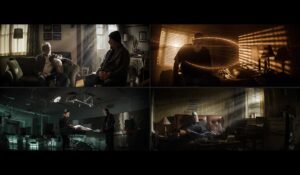
Ben Nott ACS’s work on ‘Sleeping Dogs’ released in 2024
Reflecting on the evolution of visual storytelling, Nott has observed cycles in the emphasis placed on cinematographic craft. “I felt that early films I used to watch were incredibly crafted. The 80s had some beautifully crafted films. I felt that there was a window when the craft seemed to diminish; in the television world, there was definitely a time where flat and quick and fast became a thing but I’d say in the last 15 years or so, it’s really gravitated back towards incredibly high-end big production value. I’ve been really enamoured by the visual quality of a lot of the content that’s on TV – it’s incredibly well crafted.”
Nott maintains a strong conviction about the importance of image quality and articulates a philosophy that rejects mediocrity. “It breaks my heart when you hear someone say, ‘I don’t care, let’s just shoot. I don’t care, I’ve just got to get the day’. There’s no such thing as it looks fine – it’s either good or it’s fucked – anything in between is absolutely unacceptable. I almost prefer completely shit because shit at least is a look, in the middle is just nothing – it’s cardboard.”
In an era increasingly dominated by reference-based filmmaking, Nott remains committed to pursuing original visual expression. “If I’m working with someone and they’re constantly referencing a shot by this director or a shot in that movie , I say to them, ‘let’s do the YOU shot, let’s do the film WE’RE making shot, let’s create OUR statement that other people reference.'” This commitment to originality extends to his approach to director collaborations. “When I begin a relationship with a director, I’m interested in finding the fabric of the film they want to make, I don’t want to find that fabric in a whole bunch of other films that we montage together to create this film – that’s of little interest to me.”
Nott acknowledges the prevalence of moodboards and visual references in contemporary filmmaking but distinguishes between using references to establish a shared visual vocabulary and slavishly imitating existing work. “I’m not saying that moodboards are bad, they’re very important tools to establish a vocabulary, a visual vocabulary.” Nott is aware that this stance requires diplomatic handling to avoid coming across as arrogant. Nevertheless, he remains steadfast in his commitment to creative originality: “What I’m actually most interested in is creating an original piece of communication if I can. And I’m not saying that’s always possible. But I’m saying wherever possible, let’s try and reach for the original solution, rather than the well-trodden solution.”
Nott observes that the emotional rhythm of a career in filmmaking differs significantly from more conventional professions, “an accountant, a hairdresser or whatever, and none of this is a denigration, it’s just an observation, they will live in a sine wave kind of vibration in that they can count the number of peaks and troughs till the next holiday, or the next major event in their life.” In contrast, the film industry creates more extreme emotional fluctuations. “We tend to be tied to a seismic type existence – there’s nothing happening in our life, we’ve got no prospects, a flat line – and then suddenly a job comes in and the earthquake happens. Over the course of the production our emotions and adrenals fluctuate wildly. The conclusion of each project creates its own emotional challenge. Your adrenals and your whole system need a complete recalibration because you just stressed the crap out of it in terms of cortisol and all that sort of thing. Suddenly you’re back in this kind of flat line situation going, ‘is that going to happen again?’”
The cycle continues with a period of uncertainty, waiting for the next opportunity, fingers drumming with anticipation. This cycle of anticipation, intensity, and uncertainty defines the career for most practitioners. “The vast majority of us live in this kind of world and I think we’re both attracted and repulsed by it, the highs are so high and awesome.” Despite these challenges, the tangible creative output provides unique satisfaction. “The fact that you can take home something tactile as a cinematographer, look at your work and say ‘I did that’ makes me immensely happy.”
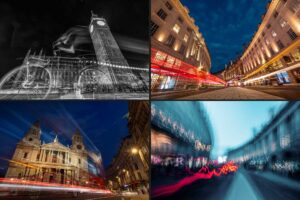
A selection from Ben Nott ACS’s personal timelapse collection
Amid the collaborative intensity of filmmaking, Nott maintains a personal photographic practice that serves as both creative outlet and therapeutic counterbalance. “We’re all drug addicts. We’re addicted to this, whatever this is. And so part of that addiction is the therapy that’s required and part of that for me is the photography. I guess it’s where I’ll gravitate back to once I decide that I don’t want to be in the circus anymore. I can do it as a single entity, I don’t need to have someone hand me the job. I don’t need a budget or 30, 50, 100, 300 people. I can do it all myself and so I find it cathartic.”
Nott has focused on creating physical photo books, responding to what he sees as a loss of tactility in digital photography. “In the digital age it’s become a splatter gun approach, people scroll through a hundred thousand photos. As kids, our parents had photo albums and periodically we’d all huddle around the photo albums and look at our lives. And that in some ways is lost because we’ve just got a phone full of shit or we’ve got hard drives poked in a drawer full of stuff.” The physical permanence of books appeals to Nott on multiple levels. “It’s something my daughter can have forever. And I guess there’s a little bit of ego in kind of having a legacy if I was to be totally honest, but also I find it really rewarding to be able to touch and feel and have a tactility to the digital image that I used to have with the photochemical process.”
When working on film projects, Nott always maintains his connection to still photography. “I always have a still camera. I always have a bunch of lenses.” Recently, he has become particularly interested in time-lapse photography. “I get so lost in the process crafting something that compresses hours into seconds; the chosen frame changes so subtly that big shifts can remain unobvious until processing accelerates them, adding this weird kinetic energy and shape shifting magic to what is essentially the same composition. I find it powerfully addictive. The further I venture down the rabbit hole the more capable I am previsualizing that inevitable change bound to happen within a frame, given what we camera folk understand about sun path, wind, tide, cloud movement etc. Strange also in that, in a very rudimentary way, I start visualizing the passing of time in real time.
Throughout his remarkable journey from outback Queensland to international productions, Nott has maintained a unique approach to cinematography that balances technical understanding with creative intuition. By refusing to be “married to the manual” and instead embracing experimentation and originality, he has developed a distinctive visual style that continues to evolve with each project and is adaptable to each director partnership.
His early scientific education provided him with an understanding of light, optics, and physical principles that informs his work without constraining it. This foundation allows him to approach technical challenges with confidence while maintaining space for creative exploration. The darkroom revelation that launched his career perfectly encapsulated this fusion of science and art—a moment where chemistry, physics, and creativity converged to produce something astounding.
As he looks to the future, Nott remains committed to the principles that have guided his career: practical problem-solving, scientific understanding, and the relentless pursuit of visual originality. In an industry increasingly dominated by technical specifications and reference-based filmmaking, Ben Nott ACS stands as a testament to the enduring value of intuition, experimentation, and the courage to forge one’s own path—qualities that have cemented his status as one of Australia’s most respected and innovative cinematographers.
Nott sums up his career with a mixture of wonder, bemusement and his trademark pragmatism: “It’s a funny old game that we fell into!”
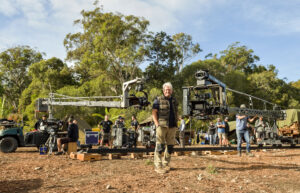
Ben Nott ACS on the set of ‘Danger Close: The Battle of Long Tan’
Website: bennottdp.com
Instagram: @bennottdpp